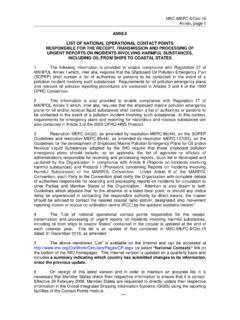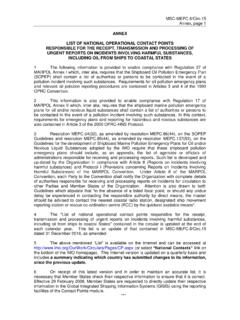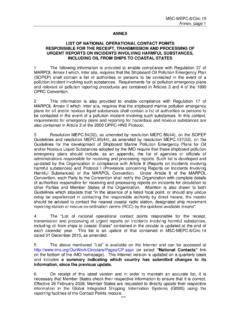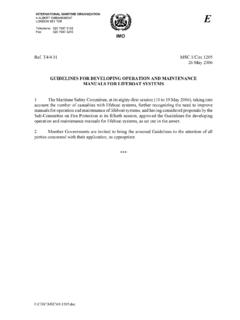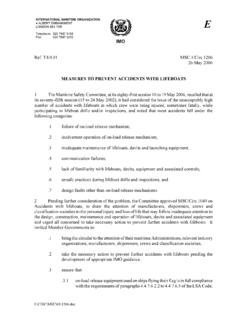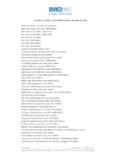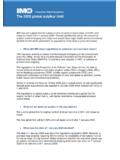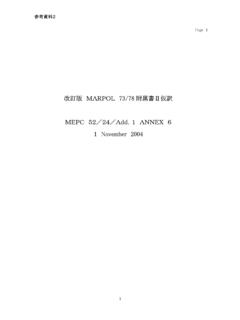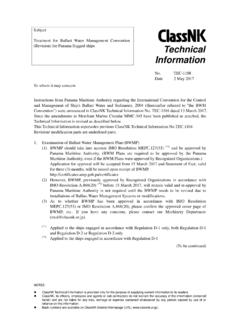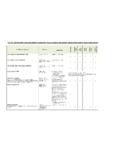Transcription of RESOLUTION MEPC.282(70) (Adopted on 28 …
1 RESOLUTION (70). (Adopted on 28 October 2016). 2016 GUIDELINES FOR THE DEVELOPMENT OF. A SHIP ENERGY EFFICIENCY MANAGEMENT PLAN (SEEMP). RESOLUTION (70). (Adopted on 28 October 2016). 2016 GUIDELINES FOR THE DEVELOPMENT OF. A SHIP ENERGY EFFICIENCY MANAGEMENT PLAN (SEEMP) mepc 70/18 Annex 10, page 1. ANNEX 10. RESOLUTION (70). (Adopted on 28 October 2016). 2016 GUIDELINES FOR THE DEVELOPMENT OF. A SHIP ENERGY EFFICIENCY MANAGEMENT PLAN (SEEMP). THE MARINE ENVIRONMENT PROTECTION COMMITTEE, RECALLING article 38(a) of the Convention on the International Maritime Organization concerning the functions of the Marine Environment Protection Committee (the Committee). conferred upon it by international conventions for the prevention and control of marine pollution from ships, RECALLING ALSO that it adopted, by RESOLUTION (62), Amendments to the annex of the Protocol of 1997 to amend the International Convention for the Prevention of Pollution from Ships, 1973, as modified by the Protocol of 1978 relating thereto (inclusion of regulations on energy efficiency for ships in MARPOL Annex VI)
2 , NOTING that the aforementioned amendments to MARPOL Annex VI, which included a new chapter 4 on regulations on energy efficiency for ships in Annex VI, entered into force on 1 January 2013, NOTING ALSO that regulation 22 of MARPOL Annex VI, as amended, requires each ship to keep on board a ship specific Ship Energy Efficiency Management Plan, taking into account guidelines developed by the Organization, NOTING FURTHER that it adopted, by RESOLUTION (70), amendments to MARPOL. Annex VI related to the data collection system for fuel oil consumption which are expected to enter into force on 1 March 2018 upon their deemed acceptance on 1 September 2017, RECOGNIZING that the aforementioned amendments to MARPOL Annex VI require the adoption of relevant guidelines for uniform and effective implementation of the regulations and to provide sufficient lead time for industry to prepare, HAVING CONSIDERED, at its seventieth session, draft 2016 Guidelines for the development of a Ship Energy Efficiency Management Plan (SEEMP), 1 ADOPTS the 2016 Guidelines for the development of a Ship Energy Efficiency Management Plan (SEEMP) (the 2016 Guidelines), as set out in the annex to the present RESOLUTION .
3 2 INVITES Administrations to take the annexed 2016 Guidelines into account when developing and enacting national laws which give force to and implement requirements set forth in regulations 22 and 22A of MARPOL Annex VI, as amended;. 3 REQUESTS the Parties to MARPOL Annex VI and other Member Governments to bring the annexed 2016 Guidelines to the attention of masters, seafarers, shipowners, ship operators and any other interested groups;. 4 AGREES to keep the 2016 Guidelines under review in light of the experience gained with their implementation;. 5 SUPERSEDES the 2012 Guidelines for the development of a Ship Energy Efficiency Management Plan (SEEMP), adopted by RESOLUTION (63). Documents/English/ mepc (E).docx RESOLUTION (70). (Adopted on 28 October 2016). 2016 GUIDELINES FOR THE DEVELOPMENT OF. mepc 70/18 A SHIP ENERGY EFFICIENCY MANAGEMENT PLAN (SEEMP). Annex 10, page 2.
4 ANNEX. 2016 GUIDELINES FOR THE DEVELOPMENT OF. A SHIP ENERGY EFFICIENCY MANAGEMENT PLAN (SEEMP). CONTENTS. 1 INTRODUCTION. 2 DEFINITIONS. PART I OF THE SEEMP: SHIP MANAGEMENT PLAN TO IMPROVE ENERGY EFFICIENCY. 3 GENERAL. 4 FRAMEWORK AND STRUCTURE OF PART I OF THE SEEMP. 5 GUIDANCE ON BEST PRACTICES FOR FUEL-EFFICIENT OPERATION OF SHIPS. PART II OF THE SEEMP: SHIP FUEL OIL CONSUMPTION DATA COLLECTION PLAN. 6 GENERAL. 7 GUIDANCE ON METHODOLOGY FOR COLLECTING DATA ON FUEL OIL. CONSUMPTION, DISTANCE TRAVELLED AND HOURS UNDERWAY. 8 DIRECT CO2 EMISSIONS MEASUREMENT. APPENDIX 1 SAMPLE FORM OF SHIP MANAGEMENT PLAN TO IMPROVE ENERGY. EFFICIENCY. APPENDIX 2 SAMPLE FORM OF SHIP FUEL OIL CONSUMPTION DATA COLLECTION. PLAN. APPENDIX 3 STANDARDIZED DATA REPORTING FORMAT FOR THE DATA. COLLECTION SYSTEM. Documents/English/ mepc (E).docx RESOLUTION (70). (Adopted on 28 October 2016). 2016 GUIDELINES FOR THE DEVELOPMENT OF.
5 A SHIP ENERGY EFFICIENCY MANAGEMENT PLAN (SEEMP) mepc 70/18 Annex 10, page 3. 1 INTRODUCTION. The Guidelines for the development of a Ship Energy Efficiency Management Plan have been developed to assist with the preparation of the Ship Energy Efficiency Management Plan (SEEMP) required by regulation 22 of MARPOL Annex VI. There are two parts to a SEEMP. Part I provides a possible approach for monitoring ship and fleet efficiency performance over time and some options to be considered when seeking to optimize the performance of the ship. Part II provides the methodologies ships of 5,000 gross tonnage and above should use to collect the data required pursuant to regulation 22A of MARPOL Annex VI and the processes that the ship should use to report the data to the ship's Administration or any organization duly authorized by it. A sample form of the SEEMP is presented in appendices 1 and 2 for illustrative purposes.
6 A standardized data reporting format for the data collection system is presented in appendix 3. 2 DEFINITIONS. For the purpose of these Guidelines, the definitions in MARPOL Annex VI apply. "Ship fuel oil consumption data" means the data required to be collected on an annual basis and reported as specified in appendix IX to MARPOL Annex VI. "Safety management system" means a structured and documented system enabling company personnel to implement effectively the company safety and environmental protection policy, as defined in paragraph of International Safety Management Code. PART I OF THE SEEMP: SHIP MANAGEMENT PLAN TO IMPROVE ENERGY EFFICIENCY. 3 GENERAL. In global terms it should be recognized that operational efficiencies delivered by a large number of ship operators will make an invaluable contribution to reducing global carbon emissions. The purpose of part I of the SEEMP is to establish a mechanism for a company and/or a ship to improve the energy efficiency of a ship's operation.
7 Preferably, this aspect of the ship-specific SEEMP is linked to a broader corporate energy management policy for the company that owns, operates or controls the ship, recognizing that no two shipping companies are the same, and that ships operate under a wide range of different conditions. Many companies will already have an environmental management system (EMS) in place under ISO 14001 which contains procedures for selecting the best measures for particular vessels and then setting objectives for the measurement of relevant parameters, along with relevant control and feedback features. Monitoring of operational environmental efficiency should therefore be treated as an integral element of broader company management systems. In addition, many companies already develop, implement and maintain a Safety Management System. In such case, part I of the SEEMP may form part of the ship's Safety Management System.
8 Documents/English/ mepc (E).docx RESOLUTION (70). (Adopted on 28 October 2016). 2016 GUIDELINES FOR THE DEVELOPMENT OF. mepc 70/18 A SHIP ENERGY EFFICIENCY MANAGEMENT PLAN (SEEMP). Annex 10, page 4. This section provides guidance for the development of part I of the SEEMP that should be adjusted to the characteristics and needs of individual companies and ships. Part I is intended to be a management tool to assist a company in managing the ongoing environmental performance of its vessels and as such, it is recommended that a company develops procedures for implementing the plan in a manner which limits any on-board administrative burden to the minimum necessary. Part I of the SEEMP should be developed as a ship-specific plan by the company, and should reflect efforts to improve a ship's energy efficiency through four steps: planning, implementation, monitoring, and self-evaluation and improvement.
9 These components play a critical role in the continuous cycle to improve ship energy efficiency management. With each iteration of the cycle, some elements of part I will necessarily change while others may remain as before. At all times safety considerations should be paramount. The trade a ship is engaged in may determine the feasibility of the efficiency measures under consideration. For example, ships that perform services at sea (pipe laying, seismic survey, OSVs, dredgers, etc.). may choose different methods of improving energy efficiency when compared to conventional cargo carriers. The nature of operations and influence of prevailing weather conditions, tides and currents combined with the necessity of maintaining safe operations may require adjustment of general procedures to maintain the efficiency of the operation, for example the ships which are dynamically positioned.
10 The length of voyage may also be an important parameter as may trade specific safety considerations. 4 FRAMEWORK AND STRUCTURE OF PART I OF THE SEEMP. Planning Planning is the most crucial stage of part I of the SEEMP, in that it primarily determines both the current status of ship energy usage and the expected improvement of ship energy efficiency. Therefore, it is encouraged to devote sufficient time to planning so that the most appropriate, effective and implementable plan can be developed. Ship-specific measures Recognizing that there are a variety of options to improve efficiency speed optimization, weather routing and hull maintenance, for example and that the best package of measures for a ship to improve efficiency differs to a great extent depending upon ship type, cargoes, routes and other factors, the specific measures for the ship to improve energy efficiency should be identified in the first place.


